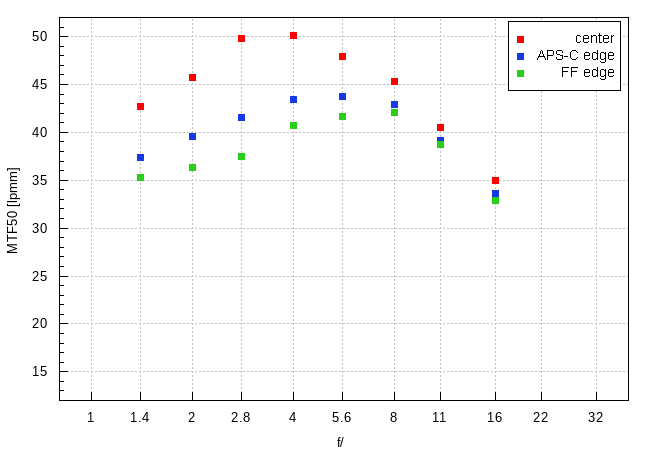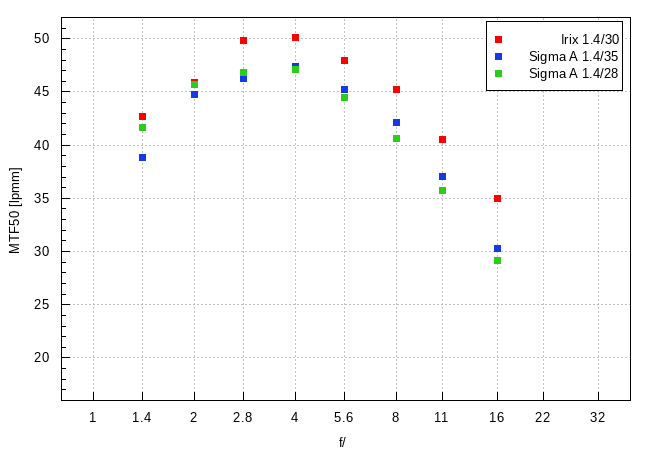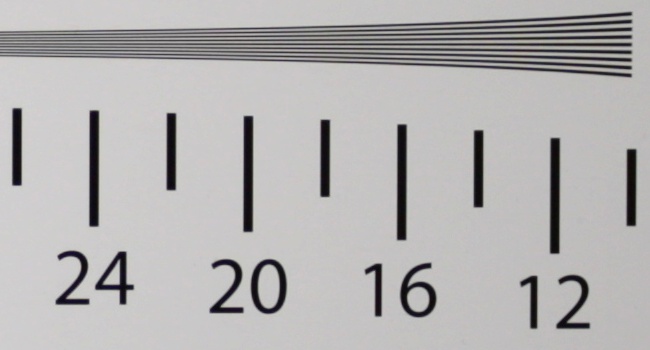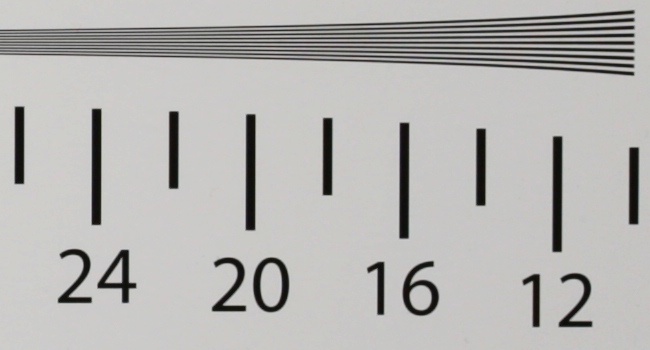Irix 30 mm f/1.4
4. Image resolution
Let’s check how the Irix 30 mm f/1.4 compares; its results in the frame centre and on the edge presents a graph below.

Please Support UsIf you enjoy our reviews and articles, and you want us to continue our work please, support our website by donating through PayPal. The funds are going to be used for paying our editorial team, renting servers, and equipping our testing studio; only that way we will be able to continue providing you interesting content for free. |
- - - - - - - - - - - - - - - - - - - - - - - - - - - - - - - - - - - - - - - - - - - - - - - -
When it comes to the performance in the centre one word is enough – a sensation. Already at the maximum relative aperture you get a very high result, reaching 42.7 lpmm; on stopping down it only gets better, and by f/4.0 it becomes outstanding with a value of 50.1 ±0.4 lpmm. It's not a new record but such a result places the Irix among a trio of the best lenses tested by us on full frame Canon sensors so far. It is also a value just slightly higher than the result of the very expensive Zeiss Otus 1.4/28.
A graph below presents a comparison between the performance of the tested Irix and two very well-put-together 28 and 35 mm Sigma lenses.

It is clear that the Irix 1.4/30 fares better at practically every aperture but I admit the huge advantage over its rivals by f/11 and f/16 seems to be a bit strange; after such a significant stopping down all lenses should have fared the same. I suppose the result is connected to aperture blades and some innacuracies of closing down. After all, at the 30 mm focal length and the f/16 aperture the hole is less than 2 mm wide; even a fraction of a milimeter can make a lot of difference in terms of resolution values.
The performance of the Irix on the edge of the frame is definitely something you should pay attention to because, for a wide-angle lens, it is simply outstanding. It's enough to say it differs just slightly from the performance in the centre of the field.
On the edge of the APS-C/DX sensor and at the maximum relative aperture you deal with a very good resolution level of over 37 lpmm; the maximum values are once again outstanding, by f/4.0 and f/5.6 amounting to a tad higher than 43 lpmm. Also the edge of full frame doesn't show even traces of any weaknesses. By f/1.4 the results exceed 35 lpmm; it means images are of at least good quality. In the aperture range from f/4.0 to f/8.0 the lens is able to exceed an excellent level of 40 lpmm.
I don't doubt that the Irix constructors profited from the fact that they hadn't been restrained by any weight and/or size limitations – because of that they constructed a lens with simply outstanding resolution.
At the end of this part of our test, traditionally we present crops taken from photos of our resolution testing chart saved as JPEG files.
| Canon 5D MkIII, JPEG, 30 mm, f/1.4 |
 |
| Canon 5D MkIII, JPEG, 30 mm, f/4.0 |
 |






